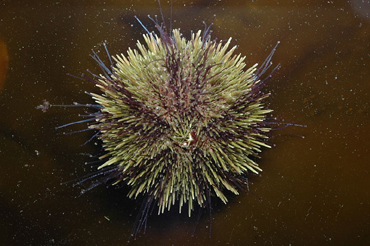People ranch just about anything these days, from llamas to emus. And the roundups aren’t limited to the land — some of them take place in the sea. One example is the sea urchin — a small, spiny creature found in much of the world. But natural stocks have been dwindling, so urchin are being raised in captivity — in tanks, cages, and undersea ranches.
 Sea urchins are being raised in captivity. Credit: Hannah Robinson
Sea urchins are being raised in captivity. Credit: Hannah Robinson The sea urchin is especially popular in Japan, where the roe — its reproductive organs — are a delicacy. In fact, Japan imports most of the world’s production of sea urchin.
But overfishing has drastically reduced the take in some fisheries. In Maine, for example, it dropped from 40 million pounds in 1993 to just five million pounds in 2009.
So several countries have established commercial aquaculture operations to increase stocks. The sea urchin is well suited to aquaculture because it matures early, grows in a hurry, and the females produce millions of eggs.
Some of these operations take place in tanks on land, others place urchin in cages in the sea, and still others place them in large, open undersea plots known as ranches.
Marine scientists are helping with these efforts. They’re helping develop better ways to grow urchin larvae in tanks, and testing diets that increase yields as well as the quality of the roe. They’re also trying to find other marine creatures that can share the undersea plots, such as Atlantic salmon and blue mussels.
Their work is helping make sure that sea urchin aren’t headed for the last roundup.

